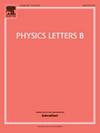Forecast constraints on the axion-photon coupling from interstellar medium heating
IF 4.3
2区 物理与天体物理
Q1 ASTRONOMY & ASTROPHYSICS
引用次数: 0
Abstract
In interstellar media characterized by a nonrelativistic plasma of electrons and heavy ions, we study the effect of axion dark matter coupled to photons on the dynamics of an electric field. In particular, we assume the presence of a background magnetic field aligned in a specific direction. We show that there is an energy transfer from the oscillating axion field to photons and then to the plasma induced by forced resonance. This resonance is most prominent for the axion mass equivalent to the plasma frequency . Requiring that the heating rate of the interstellar medium caused by the energy transfer does not exceed the observed astrophysical cooling rate, we place forecast constraints on the axion-photon coupling g for several different amplitudes of the background magnetic field . By choosing a typical value G, we find that, for the resonance mass , the upper limit of g can be stronger than those derived from other measurements in the literature. With increased values of , it is possible to put more stringent constraints on g for a wider range of the axion mass away from the resonance point.
星际介质加热对轴-光子耦合的预测约束
在以电子和重离子组成的非相对论等离子体为特征的星际介质中,我们研究了轴子暗物质与光子耦合对电场动力学的影响。特别地,我们假定在特定方向上存在一个背景磁场。我们证明了在强迫共振的诱导下,存在从振荡的轴子场到光子再到等离子体的能量传递。这种共振在与等离子体频率ωp相当的轴子质量m φ中最为突出。要求能量传递引起的星际介质加热速率不超过观测到的天体物理冷却速率,我们对几个不同背景磁场振幅的轴-光子耦合g进行了预测约束。通过选择一个典型值B0=10−6 G,我们发现,对于共振质量mϕ=ωp, G的上限可以比文献中其他测量结果的上限更强。随着B0值的增加,对于远离谐振点的轴子质量的更大范围,可以对g施加更严格的约束。
本文章由计算机程序翻译,如有差异,请以英文原文为准。
求助全文
约1分钟内获得全文
求助全文
来源期刊

Physics Letters B
物理-物理:综合
CiteScore
9.10
自引率
6.80%
发文量
647
审稿时长
3 months
期刊介绍:
Physics Letters B ensures the rapid publication of important new results in particle physics, nuclear physics and cosmology. Specialized editors are responsible for contributions in experimental nuclear physics, theoretical nuclear physics, experimental high-energy physics, theoretical high-energy physics, and astrophysics.
 求助内容:
求助内容: 应助结果提醒方式:
应助结果提醒方式:


